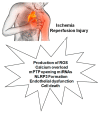Inhibitors of NLRP3 Inflammasome in Ischemic Heart Disease: Focus on Functional and Redox Aspects
- PMID: 37507935
- PMCID: PMC10376505
- DOI: 10.3390/antiox12071396
Inhibitors of NLRP3 Inflammasome in Ischemic Heart Disease: Focus on Functional and Redox Aspects
Abstract
Myocardial ischemia-reperfusion injury (MIRI) is caused by several mechanisms, including the production of reactive oxygen species (ROS), altered cellular osmolarity, and inflammatory response. Calcium overload, altered oxygen levels, and mitochondrial ROS are also involved in these MIRI processes, resulting in the irreversible opening of the mitochondrial permeability transition pore (mPTP). These mechanisms and processes are associated with NLRP3 inflammasome priming and activation, which can also induce cell death by pyroptosis through the up-regulation of the caspase-1 pathway and IL-18 release. In addition, endothelial dysfunction, both in the presence and absence of MIRI, is also accompanied by altered oxygen levels, decreased nitric oxide production, and ROS overproduction, resulting in the expression of adhesion molecules and leukocyte infiltration in which the NLRP3 inflammasome plays a central role, thus contributing, through endothelial dysfunction, to the alteration of coronary flow, typical of ischemic heart disease. Given the intricate interrelationship between ROS and NLRP3, ROS inhibitors can reduce NLRP3 inflammasome activation, while NLRP3 inhibitors can reduce oxidative stress and inflammation. NLRP3 inhibitors have been intensively studied as anti-inflammatory agents in basic cardiovascular sciences. In this review, we analyze the interrelation between ROS and NLRP3 in ischemic heart disease and the effects of some NLRP3 inhibitors as possible therapeutic agents in this disease condition. All compounds considered in this review need larger studies to confirm their appropriate use in clinical scenarios as anti-ischemic drugs.
Keywords: endothelial dysfunction; inflammation; ischemia/reperfusion injury; reactive oxygen species.
Conflict of interest statement
The authors declare no conflict of interest.
Figures


Similar articles
-
Aesculin suppresses the NLRP3 inflammasome-mediated pyroptosis via the Akt/GSK3β/NF-κB pathway to mitigate myocardial ischemia/reperfusion injury.Phytomedicine. 2021 Nov;92:153687. doi: 10.1016/j.phymed.2021.153687. Epub 2021 Aug 23. Phytomedicine. 2021. PMID: 34482222
-
Formononetin ameliorates myocardial ischemia/reperfusion injury in rats by suppressing the ROS-TXNIP-NLRP3 pathway.Biochem Biophys Res Commun. 2020 May 7;525(3):759-766. doi: 10.1016/j.bbrc.2020.02.147. Epub 2020 Mar 4. Biochem Biophys Res Commun. 2020. PMID: 32145915
-
Lipopolysaccharide (LPS) Aggravates High Glucose- and Hypoxia/Reoxygenation-Induced Injury through Activating ROS-Dependent NLRP3 Inflammasome-Mediated Pyroptosis in H9C2 Cardiomyocytes.J Diabetes Res. 2019 Feb 17;2019:8151836. doi: 10.1155/2019/8151836. eCollection 2019. J Diabetes Res. 2019. PMID: 30911553 Free PMC article.
-
Loop Between NLRP3 Inflammasome and Reactive Oxygen Species.Antioxid Redox Signal. 2022 Apr;36(10-12):784-796. doi: 10.1089/ars.2020.8257. Epub 2022 Jan 17. Antioxid Redox Signal. 2022. PMID: 34538111 Review.
-
NLRP3 Inflammasome Activation: A Therapeutic Target for Cerebral Ischemia-Reperfusion Injury.Front Mol Neurosci. 2022 May 6;15:847440. doi: 10.3389/fnmol.2022.847440. eCollection 2022. Front Mol Neurosci. 2022. PMID: 35600078 Free PMC article. Review.
Cited by
-
Deciphering Oxidative Stress in Cardiovascular Disease Progression: A Blueprint for Mechanistic Understanding and Therapeutic Innovation.Antioxidants (Basel). 2024 Dec 31;14(1):38. doi: 10.3390/antiox14010038. Antioxidants (Basel). 2024. PMID: 39857372 Free PMC article. Review.
-
Endothelial Dysfunction: Redox Imbalance, NLRP3 Inflammasome, and Inflammatory Responses in Cardiovascular Diseases.Antioxidants (Basel). 2025 Feb 23;14(3):256. doi: 10.3390/antiox14030256. Antioxidants (Basel). 2025. PMID: 40227195 Free PMC article. Review.
-
The Emerging Role of Colchicine to Inhibit NOD-like Receptor Family, Pyrin Domain Containing 3 Inflammasome and Interleukin-1β Expression in In Vitro Models.Biomolecules. 2025 Mar 3;15(3):367. doi: 10.3390/biom15030367. Biomolecules. 2025. PMID: 40149903 Free PMC article.
-
Gut Microbiota and Its Metabolites: The Emerging Bridge Between Coronary Artery Disease and Anxiety and Depression?Aging Dis. 2024 Jun 19;16(3):1265-1284. doi: 10.14336/AD.2024.0538. Aging Dis. 2024. PMID: 39012662 Free PMC article. Review.
-
Immune in myocardial ischemia/reperfusion injury: potential mechanisms and therapeutic strategies.Front Immunol. 2025 May 8;16:1558484. doi: 10.3389/fimmu.2025.1558484. eCollection 2025. Front Immunol. 2025. PMID: 40406107 Free PMC article. Review.
References
-
- Davidson S.M., Ferdinandy P., Andreadou I., Bøtker H.E., Heusch G., Ibáñez B., Ovize M., Schulz R., Yellon D.M., Hausenloy D.J., et al. Multitarget Strategies to Reduce Myocardial Ischemia/Reperfusion Injury: JACC Review Topic of the Week. J. Am. Coll. Cardiol. 2019;73:89–99. doi: 10.1016/j.jacc.2018.09.086. - DOI - PubMed
Publication types
LinkOut - more resources
Full Text Sources
Miscellaneous

